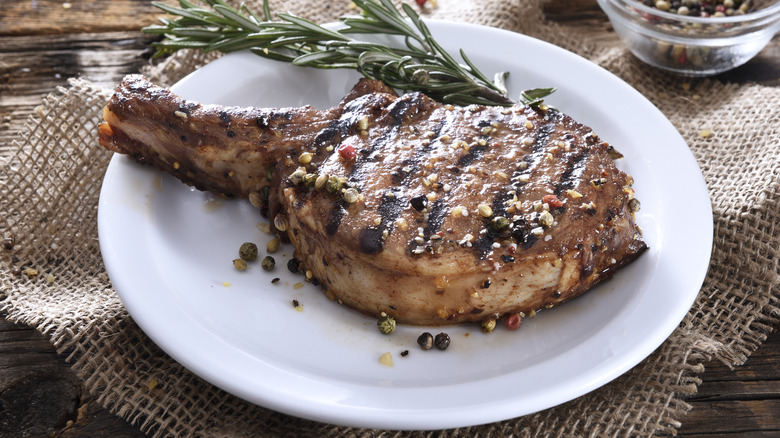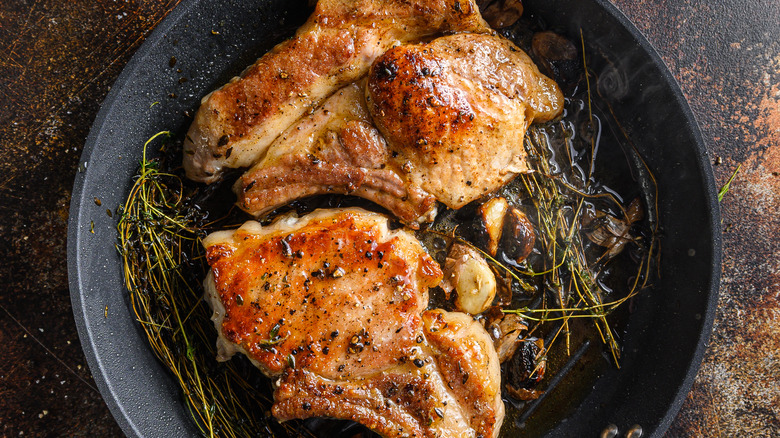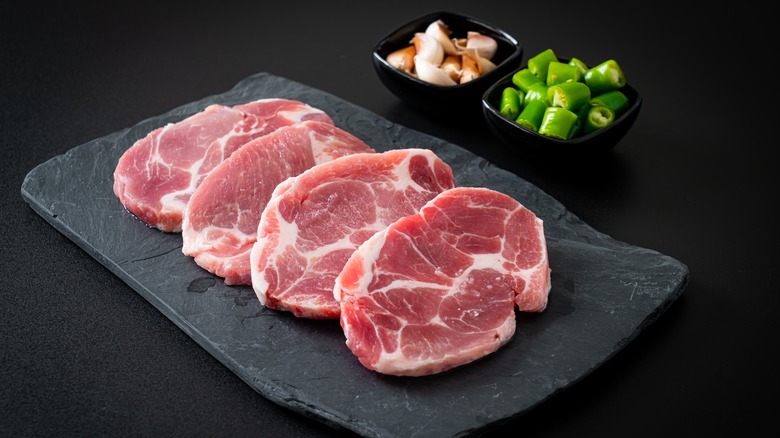The Game-Changing Rule For Flavorful Pork Chops
Pork chops have a rich culinary legacy. There is no lack of unique ways to serve up your pork chops. For example, there's the surprising ingredient in Chef Alex Guarnaschelli's pork chop recipe (pumpkin pie spice, of all things) and The Pioneer Woman's secret to getting perfect pan-fried pork chops (dredging them in seasoned flour). It seems the only real hard and fast standard is that, for food safety, the National Pork Board recommends getting your pork chops to an internal temperature of at least 145 degrees Fahrenheit. Per Healthline, consuming undercooked pork can expose you to illnesses and parasites.
Just as undercooking pork can lead to problems, going too far in the other direction can leave you with a dry and bland meal. Ideally, cooking pork at the right temperature will ensure safety while resulting in a juicier, more tender cut of meat. In addition to maintaining the correct heat, there's another way to prevent chewy and flavorless pork: by treating your swine more like bovine instead.
Just like with steaks, preparation methods for pork chops include baking, frying, and grilling. Food & Wine recommends you play up those similarities. Basting the chops in a mixture of butter and their own juices is the rule you should follow. While basting away won't guarantee you avoid the mistakes people make when grilling pork chops, preparing them as though they're cuts of beef isn't a "mis-steak" in and of itself. In fact, it's likely to make your pork as decadent as a juicy steak dish.
How to baste pork chops in butter and herbs
Basting pork chops in butter and herbs may be the best way to make them flavorful and juicy, but the final product depends on getting the basting process just right. There are many mistakes you can make when butter basting, from not pre-seasoning your meat to using too much or too little butter. Prior to basting, the cooking method involves adding salt and pepper seasoning, searing the chops in a cast-iron skillet, and finishing your meat at a lower heat.
After cooking your chops until they're "crusty and golden," Food & Wine suggests moving them over to make room on the skillet for the butter and herbs. The heat should be turned down to medium. Then the unsalted butter can be added to the cleared space, followed by whichever herbs it's being mixed with. Garlic cloves are a popular choice, but thyme and rosemary are also commonly used. More unique options, like sage, oregano, and chiles, can further boost the flavor. The herb combination will ultimately depend on your preferences, as well as which ingredients pair well together.
Once the butter and herbs are blended in the skillet, you can use a baster or a spoon to pour the mixture over the meat. Continue this for several minutes until the pork's internal temperature reaches 130 degrees Fahrenheit. At that point, the pork chops are almost ready to eat — though there's one more step you'll want to take before serving them up.
Perfect your pork chops by slicing against the grain
Basting adds flavor to your pork chops, but you'll want to perfect the dish by slicing your pork into pieces against the grain. This is a common presentation for dishes like steak-frites, and it works just as well with other cuts of meat. Cutting against the grain makes the meat more tender and easier to chew. Anyone who's struggled to get down a particularly tough steak knows how important texture is to the overall dining experience.
The "grain" refers to the muscle fibers present in meat, and it's harder to locate on lean cuts. As pork chops tend to be on the leaner side, their fibers may be difficult to pinpoint. They should resemble thin lines running through the pork. Once you find them, you'll want to cut directly across these lines rather than parallel to them. Otherwise, those eating your pork chops will need to bite through the muscle fibers themselves. That's what makes certain meats so infuriatingly chewy, and it's avoidable by slicing the grain in advance.
Such strategies should be par for the course with any meat dish, and it's clear we can learn a lot from the preparation of steak. Proper basting and cutting can elevate pork chops from a dull everyday dish to a more decadent meal. The right sides further augment this dinner option. Creamy mashed potatoes or a refreshing salad balance pork nicely, adding new flavors and textures to the mix.


